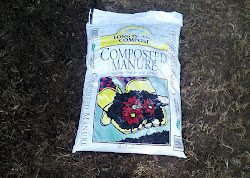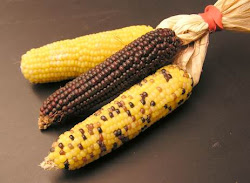Linda asks:
I think I need to add something to the lawn to help dethatch naturally.and maybe help the soil. Would spreading a commercial packaged manure mixture be helpful? At 98 cents a bag I could cover the lawn with 30 bags.
Also would you suggest an application of ammonia sulfate in the Fall to help balance the ph from years of chemicals?
thanks! ;-)
There are a few different questions here and I'll answer them one at a time. This is general advice when converting to organic lawn care.
Naturally Dethatching
First, thatch isn't a bad thing to have in your lawn. It's when you have more than a 1/2" of thatch that it can be a problem. Take a spade or shovel and cut out a square of your lawn to inspect the profile and measure the thatch layer. If it's more than 1/2" then you'll want to do something about it.
The problem with thatch is that it can prevent air, water and nutrients from going down into the roots. There are two ways to resolve this problem. One is to mechanically dethatch, the other is to core aerate. I discussed
aerating vs dethatching previously. Basically dethatching removes the thatch layer and aerating creates holes in the lawn that allow air, water, etc to penetrate into the root zone.
Soil microbes and other organisms in your soil such as earthworms will help break down the thatch but lawns that have had years of synthetic fertilizers and pesticides applied will have poor soil biology and likely soil compaction. Adding compost to the lawn will improve the soil biology as well as add organic matter in the soil.
Adding Compost
Compost does a lot of great things to the lawn. It improves the soil structure, adds organic matter, helps relieve compaction, adds nutrients and enhances soil biology. It is the best thing you can add to your soil when converting from synthetics to organics. Some microbes found in soil and compost help break down the chemicals in the lawn from synthetic fertilizers and pesticides.
The EPA has published this
information sheet on compost describing it's use for bioremediation, disease control and other issues. Compost was even effective in remediating soil that had explosives in it!
From what I've learned it's best to use a mix of compost from different sources. Compost from plant material and composted manure. I would personally go heavier with the plant based compost because if the composted manure is not composted completely it can cause problems.
30 bags of compost at I'm assuming 2 cubic feet per bag is 60 cu ft is over 2 yards. I think you'll be better off having that compost delivered in bulk. Find a local source of plant based compost that will deliver. Lay a tarp on your driveway for them to deposit it on so it doesn't create a mess. I haven't used one but I've been thinking a
Bagster Dumpster in a Bag
might be good to use. Buy a few bags of composted manure and mix it in. A pitch fork works well but you can do it with a shovel too.
If you don't have a wheelbarrow, borrow, rent or buy one to help you distribute the compost and use a rake to spread it in. The
Ames True Temper Kodiak Forged Level Head Rake
is a good rake for this purpose.
To figure out how much compost you'll need determine the square feet of your lawn area and how many inches of compost you'd like to apply. Use the following formula.
(square ft of lawn) X (inches of compost) / 12 / 27 = Yards of compost.
If you had 5000 sq ft of lawn area and you wanted to apply 1/2" of compost it would be:
5000 X .5 / 12 / 27 = 7.7 cubic yards of compost.
It's roughly 3/4 of a yard of compost per 1000 sq ft for every 1/4" of compost you want to apply.
To determine the square footage of your lawn you can use the property survey that's likely attached to your mortgage (or you can get it from your local tax assessor I think) and use that as a guide. You can even try downloading
Google Earth and using the satellite images and measuring tools to measure your lawn but going out and taking direct measurements would be the best.
Soil PH
I wouldn't add anything to the soil to adjust the pH unless I knew what the pH was. Don't guess. Send a sample of your soil to get tested by your local
university cooperative extension for analysis and use that information to adjust the pH of your soil. Most likely you'll need to add lime.
The soil report you receive will give you recommendations on nutrients in your soil but will most likely recommend synthetic fertilizer applications. You can use organics instead but will need to calculate how much fertilizer to apply. For example if they tell you your soil needs 1.5 lbs of potassium per 1,000 sq ft then you need to figure out how much of your organic fertilizer to apply to give you 1.5 lbs per 1k sq ft.
What I Would Do If I Were You
Right now is the best time to start the process.
1. Determine your soil pH either by sending a soil sample to your extension office or by using a consumer soil pH tester like the
Luster Leaf Rapitest Mini Soil pH/Moisture Tester
. If you use the soil tester it's important that the soil is moist to get an accurate reading and you should test different locations and take an average.
2. If you have more than 1/2" of thatch I would dethatch the lawn. I don't have a large lawn so I use a manual dethatcher that also helps
remove ground ivy and gives a good workout. :) If you have a larger area rent a gas powered dethatcher.
3. Whether you dethatch or not I would core aerate the lawn. Again, I have a small lawn and like to sweat so I use a
Turf Hound manual aerator. Based on how much compost you're thinking of getting I assume you'd want to rent a core aerator. Many rental places will carry them. Make sure it's a core aerator and not a spike aerator. You'll want to run the aerator over your lawn multiple times in different directions. How many times you go over your lawn will depend on your model. You want to get at least 9 holes per sq ft but as many as 20 holes per square foot if your soil is very compacted or heavy clay. I'd shoot for at least 16. Leave the plugs on your lawn, don't rake them up.
4. Apply lime and organic fertilizer as needed. I've had good results with
Espoma Bio-Tone Organic Starter Fertilizer. It has a good ratio of nutrients and contains beneficial microbes. Do not use corn gluten meal at this point if you plan on overseeding which I would.
5. Spread compost on your lawn. Get bulk compost delivered. If you can get a mix of composted plant material and composted manure that's your best bet. If not get the composted plant material and mix in some composted manure. Plain composted plant material is fine too. Because of the core aerating I would shoot for 1/2" of compost.
6. Spread a good quality grass seed over the lawn and water it as recommended to get good germination.
Starting next Spring use organic lawn fertilizers 3-4 times a year.
Corn gluten meal
in the early spring and late summer,
Ringer Lawn Restore
in late spring and mid fall would be a good star. Also using a pump sprayer (I like the
Smith 2-Gallon Max Contractor Sprayer
) to apply
soluable kelp
and
humic acid
in late spring and a one or two times during the summer would be great. You can mix the kelp and humic acid and apply them at the same time.
Also read my
mowing tips for a healthier lawn.
Hope this helps!
 before hurricane Sandy but they didn't arrive until today. They provide a decent amount of light and you don't need to worry about batteries or power. One minute of cranking provides up to an hour of light. It's enough light to read by if close and can help you find your way around a small bedroom. The lantern has a total of four LEDs but can be run with only two. Pressing the button once turns on two LEDs. Pressing the button again will turn on all four. With all four LEDs on the lantern will only run thirty minutes from one minute of cranking. The Wind 'N Go Lantern can also be charged with an optional AC adapter. Five hours of charging will provide six hours of light using two LEDs or three hours using all four. An optional cell phone charger can also be purchased to get one or two minutes of talk time from one minute of cranking.
Wind 'N Go Mini LED Lantern
before hurricane Sandy but they didn't arrive until today. They provide a decent amount of light and you don't need to worry about batteries or power. One minute of cranking provides up to an hour of light. It's enough light to read by if close and can help you find your way around a small bedroom. The lantern has a total of four LEDs but can be run with only two. Pressing the button once turns on two LEDs. Pressing the button again will turn on all four. With all four LEDs on the lantern will only run thirty minutes from one minute of cranking. The Wind 'N Go Lantern can also be charged with an optional AC adapter. Five hours of charging will provide six hours of light using two LEDs or three hours using all four. An optional cell phone charger can also be purchased to get one or two minutes of talk time from one minute of cranking.
Wind 'N Go Mini LED Lantern























